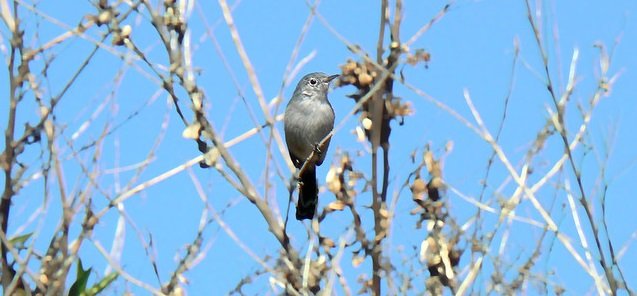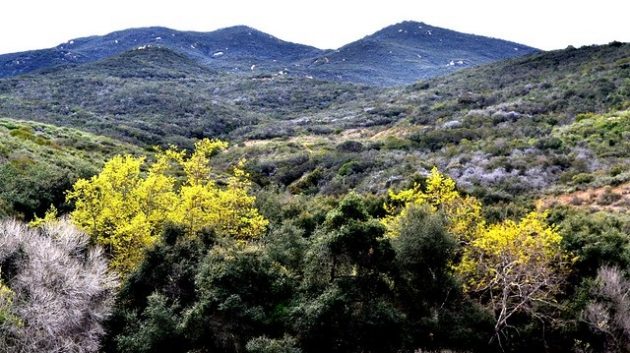
The coastal subspecies of California Gnatcatcher (Polioptila californica californica) can be found in sage scrub that was once abundant from Ventura County to northern Baja California. But its U.S. range largely consists of valuable real estate along the Southern California coast and urban development around San Diego and Los Angeles has eliminated much of its habitat. What was once sage scrub is now suburbs and highways.
As a result, the bird has a long history with the Endangered Species Act. Initially identified as a candidate for listing in 1982, it was ultimately listed as “threatened” in 1993. A critical aspect of the listing was a finding by the U.S. Fish and Wildlife Service (FWS) that the coastal subspecies was actually a subspecies. If it was not, there would be no listing, as the overall species was not in peril. FWS released a 5-year review of the species in 2010.
Because the coastal California Gnatcatcher lives on such valuable land, its “threatened” status creates economic conflicts. Thus, its listing has been contested by groups advocating more development. There has been litigation since the 1990s, including several unsuccessful efforts to overturn the listing.
More recently, a group of developers petitioned FWS to delist the gnatcatcher because the underlying science was allegedly flawed and the coastal gnatcatcher is not really a distinct subspecies. The petition relied on a genetic and ecological analysis by Dr. Robert Zink, a biologist at the University of Nebraska (the “Zink study”). FWS sought the views of six independent scientists and they all rejected the findings in the Zink study. As a result, FWS denied the petition to delist in August 2016.
After the petition was denied, some of those petitioners filed suit in U.S. District Court for the District of Columbia, arguing that FWS did not properly assess the subspecies issue.
But before it reached the merits of those arguments, the court had to determine whether the plaintiffs had “standing” to maintain the lawsuit. “Standing” is a legal doctrine that requires a plaintiff to have a personal stake in the outcome of the controversy, as required by Article III of the Constitution.
To establish standing, a plaintiff must show: (1) that it has suffered an “injury in fact” that is both “concrete and particularized” and “actual or imminent;” (2) that the injury is “fairly traceable” to the defendant’s challenged action; and (3) that it is likely “that injury will be redressed by a favorable decision.”
When the plaintiff is an organization, it may assert standing on its own behalf or on behalf of its members. The latter, which is known as “associational standing,” requires a plaintiff to show: (1) at least one member would have standing in his or her own right, (2) the interests the association seeks to protect are germane to its purpose, and (3) neither the claim asserted nor the relief requested requires an individual member to participate in the lawsuit.
Standing is often an issue in environmental lawsuits and advocacy groups have learned how to meet these requirements, sometimes including named individuals. The group and its members typically allege that they observe birds or run birding companies or have a mission to protect and preserve birds, so the “injury in fact” requirement is satisfied.
But the pro-development entities that filed the gnatcatcher lawsuit could not satisfy the standing requirement. Only one of the many plaintiffs, called the “Center for Environmental Science, Accuracy, and Reliability” (“CESAR”), even submitted any evidence to support its standing. CESAR stated it was a non-profit organization that “advocates for the use of data and the scientific method to ensure consistent application of environmental statutes.” CESAR conceded that it had no formal members, but asserted that it did have “informal members” who join a mailing list through the CESAR website.
But the court found that CESAR did not have any “true members” at all, as the alleged members did not play any part in electing leadership, or in directing activities, and did not finance CESAR’s activities. Thus, the court found that CESAR could not assert associational standing on their behalf. The court also rejected the notion that Dr. Zink, would have standing to bring a claim in his own right. CESAR had alleged that Dr. Zink would suffer professional and reputational injuries because FWS rejected his research, but the court found that inadequate.
As a result, the court determined that none of the plaintiffs had standing and the case was dismissed on that basis, without ever reaching the merits of the arguments. Thus, the court did not even address the science regarding taxonomy and connectivity, which continues to develop.
The time to appeal has lapsed, so that is the end of this particular case. However, because the California Gnatcatcher occupies such valuable real estate on the southern California coast, further litigation regarding its listing status is virtually inevitable.

Case citation: Ctr. for Envtl. Sci., Accuracy & Reliability v. United States DOI, 2019 U.S. Dist. LEXIS 110982, 2019 WL 2870131 (D.D.C. 2019).
Photos: California Gnatcatcher by Pacific Southwest Region USFWS; coast sage habitat by Pacific Southwest Region USFWS.












“It is clear that Congress intended to halt and reverse the trend toward species extinction whatever the cost.”–Chief Justice Warren Burger